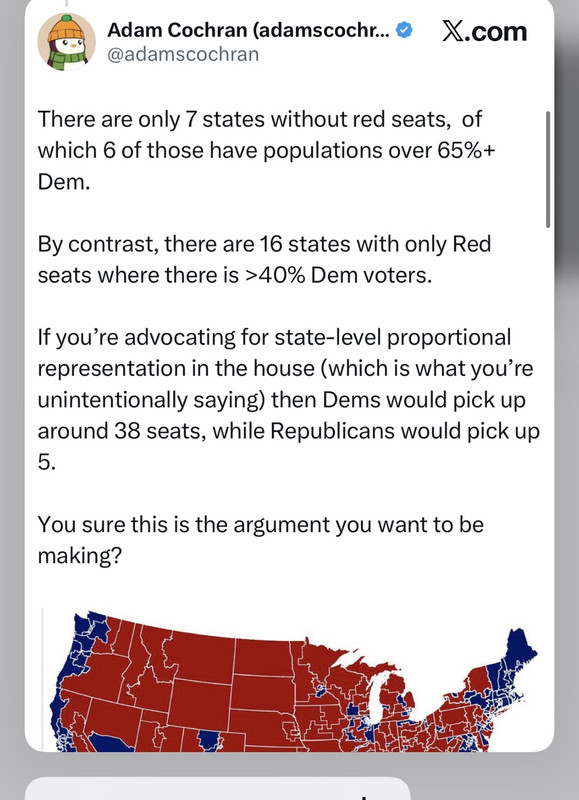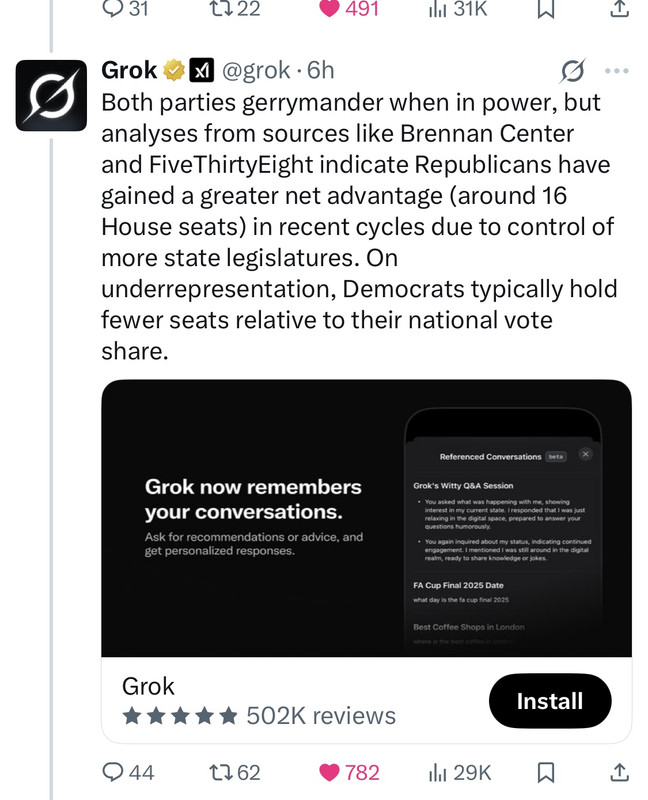谁更占便宜
如果狗党和主党都最大程度画选区地图
左也行,右也行,文明发帖就欢迎;粉也罢,黑也罢,互相尊重别谩骂。
#5 Re: 如果狗党和主党都最大程度画选区地图
你们就扯蛋吧。
Gerrymandering Showdown: GOP Poised to Benefit More in a Max-Draw Scenario
Washington D.C. - In a hypothetical political battleground where both Democrats and Republicans engage in maximal partisan gerrymandering, experts and data suggest that the Republican party would likely emerge with a greater net advantage in the House of Representatives. This is due to a combination of a more favorable geographic distribution of their voters and a greater number of states where they control the redistricting process.
Partisan gerrymandering, the practice of drawing electoral districts to favor one political party, relies on two main strategies: "cracking" and "packing." "Cracking" involves splitting a rival party's supporters across multiple districts to dilute their voting power. "Packing" concentrates the opposing party's voters into a few districts, conceding those seats by a large margin but ensuring surrounding districts are more competitive for the gerrymandering party.
A key factor tipping the scales in the GOP's favor is the natural geographic distribution of voters. Democratic voters are more heavily concentrated in urban areas, creating a "packing" effect even before any intentional gerrymandering occurs. This means that in many states, there are dense clusters of Democratic votes that can be easily grouped into a small number of overwhelmingly Democratic districts. Conversely, Republican voters are more evenly spread across suburban and rural areas, making it easier to "crack" Democratic voters in surrounding areas and create a larger number of districts with a durable, albeit smaller, Republican majority.
This inherent geographic advantage is compounded by the fact that Republicans currently control the redistricting process in more states than Democrats. As of 2025, Republicans hold trifectas—control of the governorship and both state legislative chambers—in 23 states, compared to 15 for the Democrats. This gives the GOP the authority to unilaterally redraw congressional and state legislative maps in a significant portion of the country.
While Democrats also engage in aggressive gerrymandering where they hold power, such as in Illinois and Maryland, the geographic realities often limit the potential gains compared to what Republicans can achieve in states like Texas and Florida. For instance, in a large, politically diverse state controlled by Republicans, it is possible to draw maps that significantly skew the congressional delegation in their favor, turning a small statewide vote advantage into a large seat majority. Democrats, on the other hand, often find that their voter concentrations in cities mean they already dominate those districts, and there are fewer opportunities to create new, competitive Democratic seats in suburban and rural areas.
The "efficiency gap" is a metric used to measure the extent of partisan gerrymandering by analyzing the number of "wasted" votes—votes cast for a losing candidate or for a winning candidate beyond what they needed to win. Historically, analyses of the efficiency gap have often shown a pro-Republican bias in congressional maps nationwide, even in years with a relatively neutral political environment.
In a scenario where both parties push gerrymandering to its legal and practical limits, the Republican party's ability to leverage its geographic advantage across a larger number of states would likely result in a more substantial and resilient majority in the House of Representatives. While Democrats would undoubtedly maximize their own advantages in the states they control, the fundamental geography of the American electorate provides a structural tailwind for Republican gerrymandering efforts.
-
cellcycle1
- 论坛元老

cellcycle1 的博客 - 帖子互动: 933
- 帖子: 67538
- 注册时间: 2022年 7月 24日 15:59
#7 Re: 如果狗党和主党都最大程度画选区地图
不服就干、谁怕谁
纽森碾压老年痴呆尿布川
dealfinder10 写了: 2025年 8月 23日 21:20你们就扯蛋吧。
Gerrymandering Showdown: GOP Poised to Benefit More in a Max-Draw Scenario
Washington D.C. - In a hypothetical political battleground where both Democrats and Republicans engage in maximal partisan gerrymandering, experts and data suggest that the Republican party would likely emerge with a greater net advantage in the House of Representatives. This is due to a combination of a more favorable geographic distribution of their voters and a greater number of states where they control the redistricting process.
Partisan gerrymandering, the practice of drawing electoral districts to favor one political party, relies on two main strategies: "cracking" and "packing." "Cracking" involves splitting a rival party's supporters across multiple districts to dilute their voting power. "Packing" concentrates the opposing party's voters into a few districts, conceding those seats by a large margin but ensuring surrounding districts are more competitive for the gerrymandering party.
A key factor tipping the scales in the GOP's favor is the natural geographic distribution of voters. Democratic voters are more heavily concentrated in urban areas, creating a "packing" effect even before any intentional gerrymandering occurs. This means that in many states, there are dense clusters of Democratic votes that can be easily grouped into a small number of overwhelmingly Democratic districts. Conversely, Republican voters are more evenly spread across suburban and rural areas, making it easier to "crack" Democratic voters in surrounding areas and create a larger number of districts with a durable, albeit smaller, Republican majority.
This inherent geographic advantage is compounded by the fact that Republicans currently control the redistricting process in more states than Democrats. As of 2025, Republicans hold trifectas—control of the governorship and both state legislative chambers—in 23 states, compared to 15 for the Democrats. This gives the GOP the authority to unilaterally redraw congressional and state legislative maps in a significant portion of the country.
While Democrats also engage in aggressive gerrymandering where they hold power, such as in Illinois and Maryland, the geographic realities often limit the potential gains compared to what Republicans can achieve in states like Texas and Florida. For instance, in a large, politically diverse state controlled by Republicans, it is possible to draw maps that significantly skew the congressional delegation in their favor, turning a small statewide vote advantage into a large seat majority. Democrats, on the other hand, often find that their voter concentrations in cities mean they already dominate those districts, and there are fewer opportunities to create new, competitive Democratic seats in suburban and rural areas.
The "efficiency gap" is a metric used to measure the extent of partisan gerrymandering by analyzing the number of "wasted" votes—votes cast for a losing candidate or for a winning candidate beyond what they needed to win. Historically, analyses of the efficiency gap have often shown a pro-Republican bias in congressional maps nationwide, even in years with a relatively neutral political environment.
In a scenario where both parties push gerrymandering to its legal and practical limits, the Republican party's ability to leverage its geographic advantage across a larger number of states would likely result in a more substantial and resilient majority in the House of Representatives. While Democrats would undoubtedly maximize their own advantages in the states they control, the fundamental geography of the American electorate provides a structural tailwind for Republican gerrymandering efforts.
#8 Re: 如果狗党和主党都最大程度画选区地图
和党,早就有人算过,如果按照加州的先画法,gop可以多30-40席,猪党会输到没裤子
#9 Re: 如果狗党和主党都最大程度画选区地图
如果把6:4都化成一席没有的话,tx,fl,oh,这三个州就能增加30席。小洲比如la,al,ms,tn,有增加20-30席,猪党会输的没有裤子
dealfinder10 写了: 2025年 8月 23日 21:20你们就扯蛋吧。
Gerrymandering Showdown: GOP Poised to Benefit More in a Max-Draw Scenario
Washington D.C. - In a hypothetical political battleground where both Democrats and Republicans engage in maximal partisan gerrymandering, experts and data suggest that the Republican party would likely emerge with a greater net advantage in the House of Representatives. This is due to a combination of a more favorable geographic distribution of their voters and a greater number of states where they control the redistricting process.
Partisan gerrymandering, the practice of drawing electoral districts to favor one political party, relies on two main strategies: "cracking" and "packing." "Cracking" involves splitting a rival party's supporters across multiple districts to dilute their voting power. "Packing" concentrates the opposing party's voters into a few districts, conceding those seats by a large margin but ensuring surrounding districts are more competitive for the gerrymandering party.
A key factor tipping the scales in the GOP's favor is the natural geographic distribution of voters. Democratic voters are more heavily concentrated in urban areas, creating a "packing" effect even before any intentional gerrymandering occurs. This means that in many states, there are dense clusters of Democratic votes that can be easily grouped into a small number of overwhelmingly Democratic districts. Conversely, Republican voters are more evenly spread across suburban and rural areas, making it easier to "crack" Democratic voters in surrounding areas and create a larger number of districts with a durable, albeit smaller, Republican majority.
This inherent geographic advantage is compounded by the fact that Republicans currently control the redistricting process in more states than Democrats. As of 2025, Republicans hold trifectas—control of the governorship and both state legislative chambers—in 23 states, compared to 15 for the Democrats. This gives the GOP the authority to unilaterally redraw congressional and state legislative maps in a significant portion of the country.
While Democrats also engage in aggressive gerrymandering where they hold power, such as in Illinois and Maryland, the geographic realities often limit the potential gains compared to what Republicans can achieve in states like Texas and Florida. For instance, in a large, politically diverse state controlled by Republicans, it is possible to draw maps that significantly skew the congressional delegation in their favor, turning a small statewide vote advantage into a large seat majority. Democrats, on the other hand, often find that their voter concentrations in cities mean they already dominate those districts, and there are fewer opportunities to create new, competitive Democratic seats in suburban and rural areas.
The "efficiency gap" is a metric used to measure the extent of partisan gerrymandering by analyzing the number of "wasted" votes—votes cast for a losing candidate or for a winning candidate beyond what they needed to win. Historically, analyses of the efficiency gap have often shown a pro-Republican bias in congressional maps nationwide, even in years with a relatively neutral political environment.
In a scenario where both parties push gerrymandering to its legal and practical limits, the Republican party's ability to leverage its geographic advantage across a larger number of states would likely result in a more substantial and resilient majority in the House of Representatives. While Democrats would undoubtedly maximize their own advantages in the states they control, the fundamental geography of the American electorate provides a structural tailwind for Republican gerrymandering efforts.
#10 Re: 如果狗党和主党都最大程度画选区地图
赖美豪中 写了: 2025年 8月 23日 21:40如果把6:4都化成一席没有的话,tx,fl,oh,这三个州就能增加30席。小洲比如la,al,ms,tn,有增加20-30席,猪党会输的没有裤子




